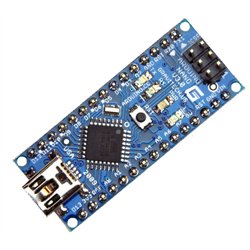
SPI is useful when transferring data between other peripheral devices and the microcontroller.
ARDUINO NANO SERIAL
11. SPIĪrduino Nano board supports the serial peripheral interface ( SPI), a communication protocol involving four pins (SCK, MOSI, MISO, SS) for communication. When triggering external interrupts in the case of an emergency, there is usage of two pins, namely pin two and pin 3. The Arduino Nano board consists of a pair of ground pins. When resetting the controller internally via software, the user should use these pins. There are two reset pins fitted on the Arduino board. (Reference pin) is the analog reference applied to the board that acts as the reference voltage when using an external power source. (3.3 Volts) is the minimum amount of voltage produced by the voltage controller mounted on the board. The 5 Volts pin is a controlled power supply used for the controller’s powering and other board components. One connects it to pin 13 of the Arduino board. This is the light-emitting diode, normally in-built in the board during construction. (Voltage IN) refers to the input voltage of the board when powering it externally. 2. Digital pinsĪrduino Nano board consists of 14 digital pins to connect its external components. Normally, the voltage range is between 0V and 5V. The Arduino nano board consists of 6 analog pins used in measuring the voltage. Now, let us study the pinout of an Arduino Nano and the description of each pin mounted on the board. How are the pins of an Arduino Nano board? The USB connection port is an extension beyond these dimensions. Request PCB Manufacturing & Assembly Quote Now Physical dimensions of the Arduino Nano boardĪn Arduino Nano board has a maximum length of 4.5 centimeters and a maximum width of 1.80 centimeters. Atmega328 has a flash memory of 32KB, an EEPROM of 1KB, and SRAM of 2KB, which is double that of Atmega168. You store the program in the flash memory, 2KB of the memory of Atmega168, which has an SRAM of 1KB. Moreover, this device is compatible with the circuit breadboard, making it easier to connect and do various electronic projects. Therefore, you cannot use an external power source to power the board. However, this board uses the mini-USB port and has no DC power jack. Most Arduino boards use the standard USB port. Additionally, this unit has a clock frequency of 16MHZ applied when generating a clock with a certain frequency at a constant voltage. However, experts recommend that the input voltage varies between 7V and 12V. The figure below shows the structure of an Arduino Nano board.Īrduino Nano operates at a voltage of 5V, with an input voltage ranging between 6V and 20V, just like other Arduino boards. These include two reset pins, six analog pins, each having a resolution of 10-bit, and six power pins mounted on the board. Additionally, this board has 14 digital pins that you can use when connecting with external components. Due to its small size, Arduino Nano is suitable for building projects requiring less storage space and fewer General-Purpose Input/output (GPIO) pins in its connection. In addition, new versions of Arduino Nano have an integrated USB. They include:Īrduino Nano is the smallest of these boards, founded on ATMEGA328P or ATMEGA628 microcontrollers, but with a connection similar to an Arduino UNO board. We connect Arduino boards to modules such as GPS, GSM, fire sensors, optical sensors, presence detectors, etc., to read their inputs and give out corresponding outputs.ĭifferent types of Arduino boards may perform similar tasks. Such tasks may include starting a motor, turning a bulb on, and printing a certain message. After reading the information, they interpret it and perform an output task. Such boards can read inputs such as a message, a pressed button, light shining on a sensor, etc. They work on the principle of input-output in the control of programmable electronic devices. These are open-sourced boards that allow for flexibility in their construction and adaptation. For example, we may require Arduino boards to perform different programming tasks in building projects and scientific instruments.
ARDUINO NANO SOFTWARE
We refer to Arduino as an open-source hardware and software company that is a designer and manufacturer of single-board microcontrollers and microcontroller kits to construct various digital devices. However, we will emphasize two of these types: Arduino nano and Arduino micro. Additionally, we will see that there are more than fifteen types of Arduino boards. We will look at the definition of Arduino, and the different types of Arduino boards.

Have you ever heard of Arduino? Or would you like to know more about Arduino? If yes, then you are in the right place.


 0 kommentar(er)
0 kommentar(er)
